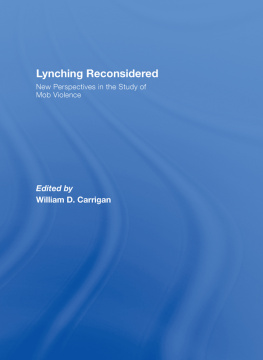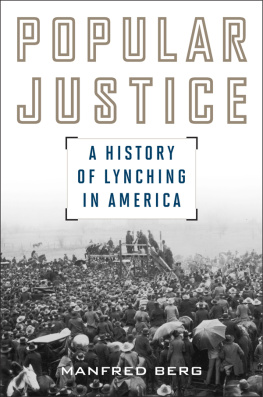Copyright 2021 by The University of Arkansas Press. All rights reserved.
No part of this book should be used or reproduced in any manner without prior permission in writing from the University of Arkansas Press or as expressly permitted by law.
ISBN: 978-1-68226-186-6
eISBN: 978-1-61075-755-3
25 24 23 22 21 5 4 3 2 1
Manufactured in the United States of America
Designed by Liz Lester

The paper used in this publication meets the minimum requirements of the American National Standard for Permanence of Paper for Printed Library Materials Z39.48-1984.
Library of Congress Cataloging-in-Publication Data
Names: Lancaster, Guy, 1976 author.
Title: American atrocity: the types of violence in lynching / Guy Lancaster.
Description: Fayetteville: The University of Arkansas Press, 2021. | Includes index. | Summary: Drawing from the fields of history, philosophy, cognitive science, sociology, and literary theory, and quoting chilling contemporary accounts, historian Guy Lancaster argues that the act of lynching encompasses five distinct but overlapping types of violenceProvided by publisher.
Identifiers: LCCN 2021010730 | ISBN 9781682261866 (paperback) | ISBN 9781610757553 (ebook)
Subjects: LCSH: LynchingUnited StatesHistory. | ViolenceUnited StatesHistory. | African AmericansUnited StatesHistory.
Classification: LCC HV6457 .L35 2021 | DDC 364.1/34dc23
LC record available at https://lccn.loc.gov/202101073
INTRODUCTION
Why did her tears reveal to me what I had learned long ago, but had forgotten in my frenzied love, that there is a draught that we must drink or not be fully human? I knew that one must know the truth. I knew quite well that when one is adult one must raise to ones lips the wine of the truth, heedless that it is not sweet like milk but draws the mouth with its strength, and celebrate communion with reality...
Rebecca West, The Return of the Soldier
AT PRESENT IN THE UNITED STATES, awareness of our shared history of racialized violence is growing, along with a desire to commemoratethat is, to remember togetherthat violence by installing markers in public places or developing classroom curricula to teach younger generations what earlier ones often learned only through the whispers of their own elders. The Equal Justice Initiative, for one, has been prominent in the public conversation, releasing its Lynching in America study in 2015 and then, three years later, opening the National Memorial for Peace and Justice in Montgomery, Alabama, a site dedicated to the memory of those who suffered slavery, lynching, segregation, and more. But there has also been an array
The public hunger for information on lynching and other cases of racialized violence has fueled, and been fueled by, an expanding output of scholarship in the disciplines of history, sociology, political science, literary studies, and others. In my own research, however, I have had to confront what might be called the limits of typology, or the fact that the terms we use to characterize various cases of racialized violencelynching, race riot, massacre, pogrom, racial cleansing, nightriding/whitecappingconstitute less discrete categories and more a blurred spectrum. Even more, the word lynching itself cannot be considered a discrete practice but, instead, covers multiple forms of violence. And by that, I do not mean only that lynching may be carried out using either a noose or a gun, practiced against either the mythical Black beast or against white horse thieves, and perpetrated either by a quiet band in the dead of night or by a whole town on the public square in the light of day. Instead, I mean that lynching, as a practice, accords with several different big picture frameworks for understanding violence, frameworks that theorists have produced across a spectrum of disciplines. These models of violence are not mutually exclusivein fact, they reinforce each other quite well and offer a variety of perspectives that provide a much deeper understanding of what lynching was and what its perpetrators wanted to accomplish.
That, then, is the motivation behind this bookto illustrate concisely the types of violence within the category of lynching, and to demonstrate how we might apply these models, especially for those who may not be aware of the wealth of theory regarding the origin and nature of violence.
were not operating at the lawless fringes of culture but were, instead, immersed in the broader, deeper culture of white supremacy. Moreover, when the mob lynched a man or woman, they did not just punish that one personthey terrorized entire communities.
analyzes lynching as objective or structural violence. This study builds upon the works of Johan Galtung and Slavoj iek to illustrate how lynching was not the eruption of violence into a peaceful world but, instead, the manifestation of a broader system of inequality and oppression. Such a representation of lynching will hinge largely upon a study of Act 258 of 1909, an Arkansas law that attempted to substitute mob violence with the expedited judgment of the court as a means of preventing lynching, while doing exactly nothing to punish the mobs for murder or to sanction officers of the law who failed to protect their charges from the wrath of vigilantes.
While lynching, like other forms of collective violence such as genocide, is frequently described as being possible only because of the persistent dehumanization of the victims-to-be, in I will argue that lynching actually constitutes humanistic violence. In fact, recognizing the humanity of the lynching victim was necessary for the mobs to receive the greatest satisfaction from their deeds. Borrowing from the works of Fritz Breithaupt, Kate Manne, and others, I intend to demonstrate that lynching parties were quite aware of the humanity of their intended victimsand sought to destroy them precisely because of it.
Violence, the theorists demonstrate, can be employed to honor, create, and sustain social relationships, and this certainly pertains to lynching, which was often justified by reference to a defense of the (white) community. Members of the mob often regarded their own deeds as heroic, and if the newspapers of the time and place did not always attach such labels to their deeds, they at leastand quite oftenportrayed the victim of lynching as representing the purest form of evil possible, thus rendering the mob a virtuous collective by contrast.
The final chapter offers a synthesis of the previous four by analyzing lynching through the lens of Ren Girards mimetic theory of violence. According to Girard, it is the nature of human beings to imitate the desires of others, which can lead to rivalry when desires converge upon the same object. This rivalry can encompass others, threatening the entire community, with peace being restored only through the mechanism of a scapegoat whose guilt is universally agreed upon. In the United States, African Americans have regularly functioned as this scapegoat, especially as they were regarded by many white men as exhibiting mimetic desire for white women. Mimetic violence is thus both humanistic, in that it attributes human qualities to its victims, as well as collective, in that it is perpetrated by a group for the restoration of its peacewhich makes said violence a virtue, too. In addition, the violent regulation of perceived desires following the Civil War was a function not only of vigilantes but also of the state, which instituted various anti-miscegenation measures to prevent cross-racial romance and solidarity, thus making violence aimed at regulating such relationships an example of objective or structural violence.











 The paper used in this publication meets the minimum requirements of the American National Standard for Permanence of Paper for Printed Library Materials Z39.48-1984.
The paper used in this publication meets the minimum requirements of the American National Standard for Permanence of Paper for Printed Library Materials Z39.48-1984.